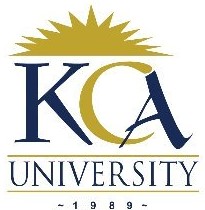 UNIVERSITY EXAMINATIONS: 2011/2012
UNIVERSITY EXAMINATIONS: 2011/2012
SECOND YEAR EXAMINATION FOR THE BACHELOR OF
SCIENCE IN INFORMATION TECHNOLOGY
BIT2103 PRINCIPLES OF ARTIFICIAL INTELLIGENCE
DATE: AUGUST, 2012 TIME: 2 HOURS
INSTRUCTIONS: Answer Question ONE and any other TWO
QUESTION ONE
a) Briefly explain the meaning of the following concepts with reference to artificial
intelligence
i. Heuristics (2 Marks)
ii. State (2 Marks)
b) Distinguish between deductive and inductive reasoning. Give one example for
each case. (4 Marks)
c) Write whether each statement is true (T) or false (F), and provide a short
explanation:
i. Uniform-cost search is a special case of Breadth- first search. (2 Marks)
ii. Breadth-first search, depth- first search and uniform-cost search are special cases
of best- first search. (2 Marks)
iii. A* is a special case of uniform-cost search. (2 Marks)
d) Briefly explain three objectives of studying artificial intelligence (3 Marks)
e) State and explain five disciplines that contribute to artificial intelligence field of
study. (5 Marks)
f) Briefly describe what expert reasoning tasks are. Explain why it be useful if we
can automate them. (3 Marks)
g) Briefly explain how artificial intelligence systems are applied used as decision
support tools. Give one example. (3 Marks)
h) Let m and represent the following statements:
m: kcau is a university ( true statement)
q: Kenya is an African country( true statement)
Use truth table to determine the truth value of the following expression
(2 Marks)
~ m ∧ (q ∨ ~m)
QUESTION TWO
a) Briefly explain the meaning of the following terms
i. Action (2 Marks)
ii. Successor function (2 Marks)
iii. Branching factor (2 Marks)
b) Describe two assumptions of knowledge representation. Use examples to illustrate
your answer. (4 Marks)
c) Distinguish between Inferential adequacy and Inferential efficient. Give one
example for each case. (4 Marks)
d) What is the definition of an admissible heuristic? (2 Marks)
e) Translate the following sentences into predicate logic.
i. No one likes winter (2 Marks)
ii. Otieno loves sweet fruits. (2 Marks)
QUESTION THREE
a) Briefly explain the meaning of the following concepts
i. Search tree (2 Marks)
ii. Search node (2 Marks)
iii. Goal (2 Marks)
b) Consider the of the following propositions
Bird is an animal
Bird has part wing
Robin is a bird
Robin is a rusty
Robin is a red
i. Construct Semantic Network (4 Marks)
ii. Convert the semantic network constructed in (3d) into predicate logic (2 Marks)
c) Explain four limitations of using rules to represent knowledge (4 Marks)
d) Explain two elements that can be used to represent Uncertainty in fuzzy logic
reasoning .Give one example for each element. (4 Marks)
QUESTION FOUR
a) Briefly describe the meaning of the term ‘search problem’ (2 Marks)
b) State and explain five elements of defining search problem. (5 Marks)
c) Translate the following rule into a frame (2 Marks)
IF (hair) OR (drinks milk) THEN (mammal)
d) Search process involves three steps. Explain each of these steps. (3 Marks)
e) Explain three reasons why we study games in artificial intelligence (3 Marks)
f) Explain the difference between mini-max and alpha beta algorithms (2 Marks)
g) Describe characteristics of informed searching methods (3 Marks)
QUESTION FIVE
a) Briefly explain the meaning of the following terms
i. Spatial Intelligence (2 Marks)
ii. State space (2 Marks)
b) Describe four types of board games that can be implemented using artificial
intelligence tasks (4 Marks)
c) The following figure shows a MIN-MAX game tree. Cross out the branches that
are pruned by alpha-beta pruning and determine the number of nodes that you did
not have to visit with alpha-beta pruning when compared to the full MIN-MAX
search. Show all intermediate values at each node as they get updated.
(4 Marks)

d) Describe four characteristics of a good searching method in the context of
artificial intelligences. (4 Marks)
e) Briefly explain the steps of depth limited search algorithm. Use Pseudocode to
illustrate your answer (4 Marks)